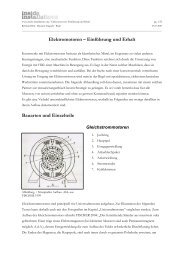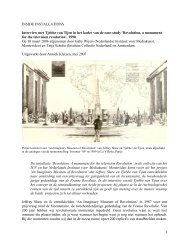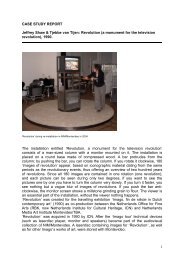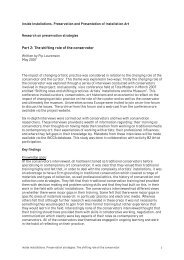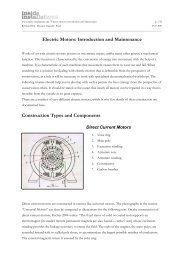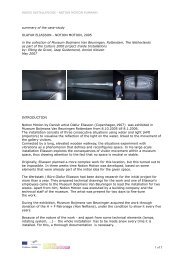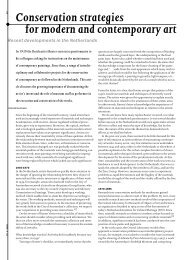GLOSSARY OF LIGHT TECHNOLOGY - Inside Installations
GLOSSARY OF LIGHT TECHNOLOGY - Inside Installations
GLOSSARY OF LIGHT TECHNOLOGY - Inside Installations
Create successful ePaper yourself
Turn your PDF publications into a flip-book with our unique Google optimized e-Paper software.
WWW.INSIDE-INSTALLATIONS.ORG <strong>GLOSSARY</strong> <strong>OF</strong> <strong>LIGHT</strong> <strong>TECHNOLOGY</strong> FRANZISKA HERZOG ZKM KARLSRUHE 16<br />
Glow Lamps<br />
cont.<br />
Halogen Lamps<br />
Heavy Current<br />
High Frequency<br />
High Pressure Discharge Lamps<br />
High Pressure Mercury Lamps<br />
A precise classification of glow lamps is provided by > ILCOS 1231<br />
or the particular > lamp manufacturers. Glow lamps are operated with<br />
mains voltage (230V). A transformer is necessary for operation. ><br />
Dimming the lamps is not possible.<br />
belong to the group of > thermal radiators.<br />
The principle of light generation and their construction is comparable<br />
to that of the > incandescent lamps. In contrast to these, halogen<br />
compounds are added to the filling gas. These allow the halogen cycle<br />
to occur and thus reduce the oxidation of the tungsten, i.e. they<br />
reduce the blackening of the glass bulb.<br />
The relatively high temperature of the lamp bulb (250 o C) requires the<br />
use of a glass with a high softening temperature e.g. quartz glass.<br />
This allows the construction of low-volume, compact lamps because of<br />
its mechanical stability.<br />
Halogen lamps have the following characteristics.<br />
They have a high > light output with a higher > colour temperature<br />
(3,300K) than incandescent lamps. These parameters can be increased<br />
depending on the halogen compound used, e.g. xenon. An increase is also<br />
possible with the use of a reflective coating (infrared coating).<br />
Touching the glass bulb, i.e. grease from fingers, results in a<br />
reduction of the > luminous flux. The average lifetime is 2,000-4,000h.<br />
The > power is 5-2,000W.<br />
A distinction is made between numerous types of construction. There<br />
are, for example, standard lamps, pyramid candle and reflector lamps.<br />
Clear or opaque glass is used for the bulb.<br />
Among the base construction types are > screw|E bases and pin|F bases.<br />
A classification of the different types of lamps is provided by > ILCOS<br />
1231 or the particular > lamp manufacturers.<br />
> High voltage halogen lamps are operated with > mains voltage (230V).<br />
> Low voltage halogen lamps (6V|12V|24V) require an additional ><br />
transformer of the appropriate voltage for operation with mains<br />
voltage.<br />
> Dimming halogen lamps is possible.<br />
> three-phase alternating current<br />
is the description in electronics for high > frequency, i.e.<br />
electromagnetic oscillations, of an > electrical current and is<br />
measured in hertz (Hz).<br />
The high frequency region of electrical current is, according to the<br />
application, over 10kHz, the low frequency region is under 10kHz.<br />
There is no precisely defined boundary to distinguish between high and<br />
low frequency. Fluorescent lamps, for example, which are operated with<br />
mains frequency (50Hz), are said to be low frequency, in contrast to<br />
the high frequency operation of a > ballast with ca. 30-40kHz.<br />
are > gas discharge lamps and are sub-divided into > high pressure<br />
sodium vapour lamps and > high pressure mercury vapour lamps on the<br />
one hand and > metal halide lamps on the other hand.<br />
High pressure discharge lamps work with a pressure of more than 1<br />
bar in a small volume, short discharge chamber with a high > luminous<br />
intensity.<br />
High pressure discharge lamps are characterised by a high > luminous<br />
flux, independent of the surrounding temperature. The > light output<br />
and the > colour rendering vary reciprocally.<br />
A > ballast is used for operation. Depending on the lamp type, an<br />
> ignition device may be used in addition, whereby a warm up time<br />
of several minutes is needed before the correct vapour pressure is<br />
achieved. A reignition i.e. cooling-time of several minutes may be<br />
needed, according to the length of the power failure.<br />
are > gas discharge lamps, more precisely > high pressure discharge<br />
lamps.<br />
The principle of light generation is based on the gas discharge of<br />
mercury and argon.<br />
The > lamp is composed of a discharge chamber, called a burner,<br />
(most often quartz glass) and an outer bulb. The burner contains the<br />
electrodes as well as the mercury and argon. The outer bulb protects<br />
the burner and the current leads from corrosion and carries the<br />
phosphor coating.<br />
High pressure mercury lamps have the following characteristics.<br />
They are distinguished by a relatively high > light output with<br />
moderate > colour rendering and vice versa. The light colour is<br />
bluish|white with a high yellow and green content.



